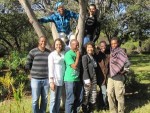Title
Maru-a-Pula, meaning “promises and blessings” in Setswana, may be the perfect description of a Juilliard student volunteer group’s return trip to Gaborone, Botswana, in June. Promises were made to the kids and the community of Gaborone, and I am very blessed to say that those promises were kept. However, it did take some faith and patience—and a lot of hard work and sacrifice—to get there.
Body
This was the second Juilliard student volunteer trip to Gaborone, and after fund-raising throughout the year and thanks in part to a Juilliard Summer Grant, we thought we were set to embark on our journey in May, shortly after commencement. But just as we were about to leave, it turned out that the outside sponsor we had very successfully worked with last year had fallen through, and had not been able to provide the airfare they promised us. By the time we were able to determine that the sponsor couldn’t help, our original departure date had passed and we soon realized we would only be able to raise enough money to send five members of the team rather than nine. At that point, we had to decide whether or not the trip would even happen this year. But then Jazz Studies master’s student Kris Bowers, new dance graduates Hassan Ingraham and Jehbreal Jackson, and drama faculty member Darryl Quinton, who was to have been our second advisor, sacrificed their spots. Thanks to them, the intimate group of third-year dancer Ernesto Breton, fourth-year actor Jeremie Harris, LeBaron McClary (B.F.A. ’10, dance), myself, and advisor Candace Feldman, who has worked for the Concert Office for several years, began our trip.
With the members we left behind in our hearts and the arts residency in our minds, we hit the ground running. We were embraced by the familiar faces of the students, faculty, and staff of the Maru-a-Pula school who hosted us. They were grateful for our return and ready to make up for lost time, which was good because we had planned that our arts residency would last four weeks—and include services, classes, and rehearsals—but that time ended up being cut in half, with only eight days to pull off a benefit performance that would match the scale of last year’s. The pressure was high, but we had the talent and drive from the students and community artists of Botswana behind us.
For the first week and a half, we began each day with students at Maru-a-Pula school, helping them with the service projects that are required as part of their curriculum. We volunteered at an animal shelter, visited children with handicaps and mental illnesses, and taught English at an orphanage where team members pretended to be lions, horses, and frogs as the kids laughed and played leapfrog as part of a game of Guess the Farm Animal.
After each morning’s service projects came two hourlong dance and drama master classes. Ernesto and LeBaron worked with 80 students on both body conditioning techniques for the experienced dancers and the basics of ballet and contemporary training for the novices.
Jeremie and I had 40 actors who ranged in age from 14 to 60, which included 25 people from Moshupa village in the southern district of Botswana. After failing or dropping out of school, they had had the opportunity to join three theater troupes formed to give dropouts a second chance as artists. The Moshupa students participated in the poetry and scene study classes, and “it was great to see them dancing, performing acting scenes, and singing in both English and Setswana,” Jeremie said. The students also did a goodbye performance and taught the Juilliard students a song. “I appreciated their boldly sharing their work and getting us involved,” he added.
The last few days of the trip were solely devoted to polishing its greatest blessing, Tapestry, a collage of six student-choreographed dance pieces and two dramatic stories showcasing the works of African-American writers Ntozake Shange, Maya Angelou, Langston Hughes, and August Wilson. For the dramatic portions, the performers recited their own poetry and had an open dialogue about what the arts can do for a community. While the drama students prepared, LaBaron and Ernesto helped the student choreographers with steps and honing the story. Thanks to the guidance and support of our advisor and sister Candace Feldman, the show was lit, designed, and run by a crew of local students she had started training when we were in Botswana last year.
Tapestry ended with the song “Ain’t No Mountain,” whose lyrics, I think, encompass the whole experience and goal of Project Maru-a-Pula 2011. There ain’t no mountain high enough, ain’t no valley low enough, ain’t no river wide enough to keep ambassadors of the arts from accomplishing their passion in creating opportunities in the arts for those who desire its immersion.





